COPYRIGHT, PLEASE NOTE
All the material on this website is copyrighted to J-P Metsavainio, if not otherwise stated. Any content on this website may not be reproduced without the author’s permission.
BUY A MUSEUM QUALITY POSTER
BUY A POSTER:https://astroanarchy.zenfolio.com/
Tuesday, January 14, 2020
Deep look to the Heart
I made some testing with my new imaging system based on Tokina AT-x 300mm f2.8 camera lens.
The CCD I'm using has kind of large pixels, 9 microns, so I'm undersampled, the image scale is almost 5 arc seconds / pixel. Undersampling is not a bad thing when my targets are large and dim nebula complexes. This system collects photons very fast!
The CCD I'm using has kind of large pixels, 9 microns, so I'm undersampled, the image scale is almost 5 arc seconds / pixel. Undersampling is not a bad thing when my targets are large and dim nebula complexes. This system collects photons very fast!
I selected the Heart Nebula as a target since I have plenty of reference material for it. Another reason is interesting and rarely imaged area after the bright tip of the heart. There are some remnants of a supernova explosion. I was really thrilled, when I saw the final stack of 12 600s H-alpha light frames. (Equal to 2h of exposures) I never have seen so much background nebulae and details from this popular target.
Beside 2h of H-alpha (Light from an ionized hydrogen) I shot 30 min of O-IIII (Light from an ionized Oxygen) To be able to make an image in visual palette.
The Heart Nebula, IC 1805
Please, click for a large image
Going very deep just in two hours! Image is in visual color palette from emission of an ionized hydrogen and oxygen. R=hydrogen, G=Oxygen and B=oxygen. I have made a starless version out of this image, it can be seen here, https://astroanarchy.blogspot.com/2020/01/an-animated-heart-nebula-ic1805805-with.html
An older image of the area from 2011
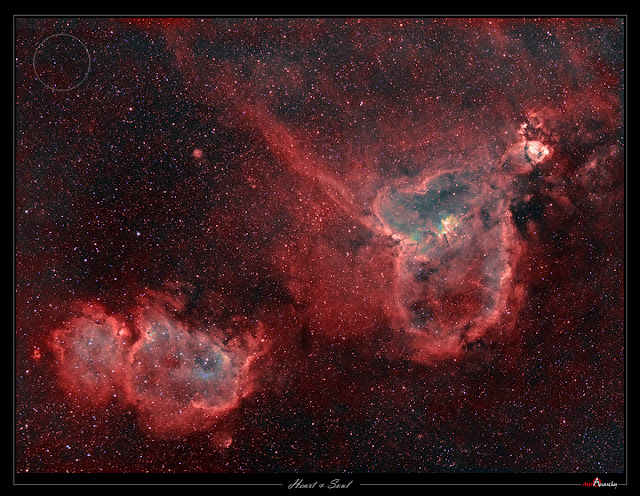
Note, there is a white circle showing an apparent size of the Moon at upper left corner to show the scale in the sky. More info about this older image can be seen here, https://astroanarchy.blogspot.com/2011/05/wide-field-vs-closeups-north-america_21.html
Technical details
Processing workflow
Image acquisition, MaxiDL v5.07.
Stacked and calibrated in CCDStack2.
Deconvolution with a CCDStack2 Positive Constraint, 33 iterations, added at 50% weight
Color combine in PS CS3
Levels and curves in PS CS3.
Imaging optics
Tokina AT-x 300mm f2.8 camera lens
Mount
10-micron 1000
Cameras and filters
Imaging camera Apogee Alta U16 and Apogee seven slot filter wheel
Guider camera, Lodestar x 2 and an old spotting scope of Meade LX200
Astrodon filters,
5nm H-alpha 3nm S-II and 3nm O-III
5nm H-alpha 3nm S-II and 3nm O-III
Total exposure time
H-alpha, 12 x 600 s, binned 1x1 = 2 h
O-III, 3x 600 s, binned 1x1 = 30 min..
O-III, 3x 600 s, binned 1x1 = 30 min..
Second light for my wide field imaging system
At January 10. I shot few lights for this busy area in Cassiopeia from the Bubble Nebula to Cave nebula. The Tokina 300mm AT-x f2.8 camera lens combined to Apogee Alta U16 camera is a very good to capturing photons. The combination of fast f2.8 optics and 9 micron pixels, (4096 x 4096 pixels) goes very deep very fast. (First light photo here, https://astroanarchy.blogspot.com/2020/01/first-light-for-winter-season-2019-20.html)
From Bubble to Cave Nebula
Please, click for a large image!
Image is in mapped colours, from the emission of ionized elements, R=Sulphur, G=Hydrogen and B=Oxygen. The signal for ionized oxygen,.
No Stars
Please, click for a large image!
Please, click for a large image!
An experimental starless image to show the actual nebula formation better.
Orientation
Please, click for a large image!
The area of the new photo is marked as a white rectangle. Info about this image here, https://astroanarchy.blogspot.com/2014/01/a-grande-finale-of-cepheus-project.html
Technical details
Processing workflow
Image acquisition, MaxiDL v5.07.
Stacked and calibrated in CCDStack2.
Deconvolution with a CCDStack2 Positive Constraint, 33 iterations, added at 50% weight
Color combine in PS CS3
Levels and curves in PS CS3.
Imaging optics
Tokina AT-x f2.8 camera lens
Mount
10-micron 1000
Cameras and filters
Imaging camera Apogee Alta U16 and Apogee seven slot filter wheel
Guider camera, Lodestar x 2 and an old spotting scope of Meade LX200
Astrodon filters,
5nm H-alpha 3nm S-II and 3nm O-III
5nm H-alpha 3nm S-II and 3nm O-III
Total exposure time
H-alpha, 18 x 600 s, binned 1x1 = 2,5 h
O-III, 6x 600 s, binned 1x1 = 1 h.
S-II, 2 x 600 s. binned 1x1 = 20 min.
Labels:
Narrowband color images,
nebula
Monday, January 13, 2020
The Frankenstein monster, my current imaging setup
First time at this Winter season 2019-20 I have a clear sky and somehow functional imaging system.
I managed to mate Apogee Alta U16 + filter wheel with my old second hand Tokina AT-x 300mm f2.8 camera lens.
Lots of self made mechanical tweaks was needed to make this work out.. (I used even an angle grinder to cut off ”unnecessary” parts of the lens to have correct back focus distance)
The result looks more like a Frankenstein monster. It’s alive!!!
"New" imaging setup
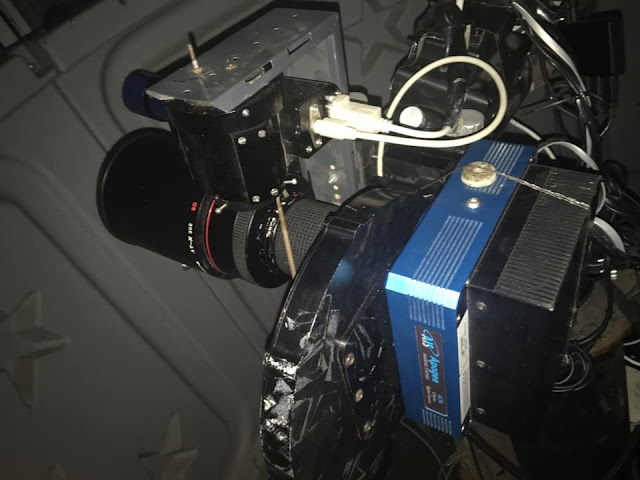
Apogee Alta U16 with a filter wheel and Tokina AT-x f2.8 camera lens n th 10-micron 1000 mount.
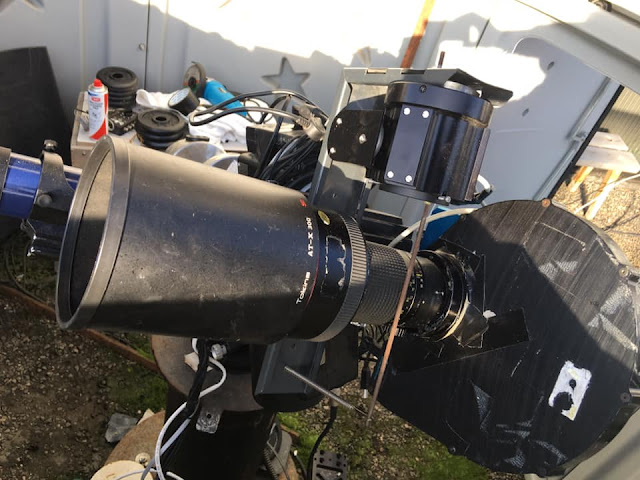
The focusing system is build around the TCF-s focuser. Focusing is done by a spring loaded round metal file over the focusing ring. This is a very accurate autofocusing system and it's temperature compensating too.
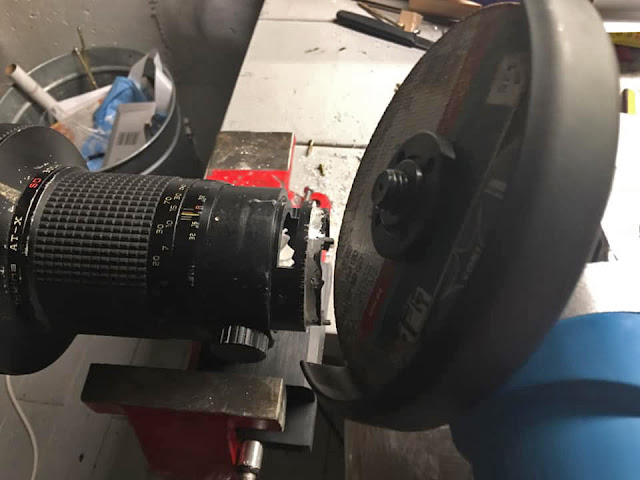
Shortening the lens, bajonet and aperture control ring are removed and I'm just about to cutting off the filter holder area. The current imaging system is kind of crazy combination. Actually it shouldn't work at all but with a angle grinder and self made adapter I was able to mate Tokina AT-x 300mm f2.8 optics to Apogee Alta U16 camera and filter wheel. There is also a temp compensating focusing system made from TCF-s focuser, L-shape metal from an old table, round metal file and a spring from an old desk lamp. The CCD is very large, over 36 x 36 mm but for some reason the lens can lit the whole area with a very little coma at most outer corners.
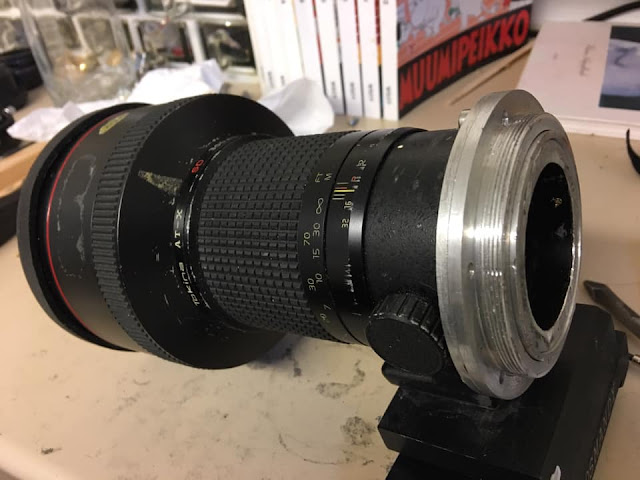
Self made adapter for the Apogee filter wheel attached.
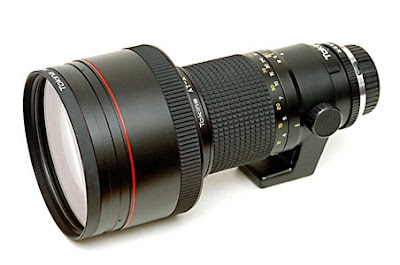
Original untouched lens.
First light photo for this system
Image analysis with CCDinspector
Click for a large image
This works way better than I thought! The whole oversize CCD is lit, there are some coma at corners but it'll be easy to crop out by removing narrow areas from left and right or from up and bottom.
Image of the full uncropped frame
(reduced 50% due to large size)
Image of the full uncropped frame
(reduced 50% due to large size)
Labels:
equipments,
Tokina 300mm f2.8 images
First light for the Winter season 2019-20, latest ever
I haven't post any new images since March 4. 2019, this is the first light for this Winter season!
I have had some technical problems with my "new" imaging system and the weather up here has been really bad for several months.
I have had some technical problems with my "new" imaging system and the weather up here has been really bad for several months.
The new imaging system is kind of temporary solution, since I'll have new camera and optical configuration in near future. The current system is interesting combination, a massive Apogee Alta U16 camera and filter wheel is mated with Tokina AT-x 2.8 camera lens. To make this combo to work, I had to modified the camera lens heavily. I cut a way part of the lens body with the angle grinder to have enough back focus distance. (I cut a way aperture control ring and filter holder part of the lens since they are not needed in astrophotography.) I'll post some pictures soon. EDIT, here are some info and images about this configuration
First light for the Winter 2019-20, IC 1396
Please, click for a full size photo
Image is in mapped colours, from the emission of ionized elements, R=Sulphur, G=Hydrogen and B=Oxygen. The signal for ionized oxygen,.
A close up
Please, click for a full size photo
Not a bad resolution for a 300mm camera lens!
There are a tiny planetary nebula PM 1-333 visible in this image, as a howk eyed Jussi Kantola pointed out in Facebook.
Not a bad resolution for a 300mm camera lens!
There are a tiny planetary nebula PM 1-333 visible in this image, as a howk eyed Jussi Kantola pointed out in Facebook.
Planetary Nebula?
Please, click for a full size photo
An experimental starless version
Please, click for a full size photo
The planetary nebula candidate at middle left stands out well in this starless photo of IC 1396 area.
INFO
H-alpha, 12 x 600 s, binned 1x1 = 2 h
O-III, 6x 600 s, binned 2x2 = 1 h.
S-II, 3 x 600 s. binned 2x2 = 0,5 h
Just left from the IC 1396 seems to be a circular formation with some weak O-III emission. Could this be a planetary nebula? I must check this soon from the astronomical database or if somebody knows this, please. let me know.
UPDATE!
UPDATE!
Ny friend Sabik Rasool, a planetary nebula enthusiast, Find out that this formation is a HII area discovered in 2015. This doesn't rule out, that this could be an ancient planetary nebula though.
An experimental starless version
Please, click for a full size photo
The planetary nebula candidate at middle left stands out well in this starless photo of IC 1396 area.
IC 1396 spans hundreds of light years at distance of about 3000 light years in constellation Cepheus. The famous formation of glowing gases, the "Elephant's Trunk Nebula" can be seen at four o'clock position.
This is an active star formation region and it has several massive young stars inside it, coursing the ionization of elements of this emission nebula.
Technical details
Processing workflow
Image acquisition, MaxiDL v5.07.
Stacked and calibrated in CCDStack2.
Deconvolution with a CCDStack2 Positive Constraint, 33 iterations, added at 50% weight
Color combine in PS CS3
Levels and curves in PS CS3.
Imaging optics
Tokina AT-x f2.8 camera lens
Mount
10-micron 1000
Cameras and filters
Imaging camera Apogee Alta U16 and Apogee seven slot filter wheel
Guider camera, Lodestar x 2 and an old spotting scope of Meade LX200
Astrodon filters,
5nm H-alpha 3nm S-II and 3nm O-III
5nm H-alpha 3nm S-II and 3nm O-III
Total exposure time
H-alpha, 12 x 600 s, binned 1x1 = 2 h
O-III, 6x 600 s, binned 2x2 = 1 h.
S-II, 3 x 600 s. binned 2x2 = 0,5 h
Labels:
Narrowband color images,
nebula
Tuesday, December 31, 2019
Happy New Year 2020
The year 2019 was very quiet regarding astronomical imaging. I'm building up a new imaging system with new optics and camera. Lots have been done though, I have been in many imaging conferences as a speaker. Beside that, I have been working in a book project with some of the most famous names in the world. I'll wrote more about this book next year before it's published at Spring 2020!
SILENT FIREWORKS FOR THE YEAR 2020
Info about the photo above:
Saturday, November 2, 2019
Art exhibition in Tampere, Finland
An exhibition of my astronomical photos in Tampere, Finland
Opening at Wednesday 6.11.2019 18.00, welcome!
Before the actual opening at 17.30 I'm talking about my work as an astronomical photographer.
Q-GALLERIA OJAKATU 3, TAMPERE. OPEN WE-FR 13-18, SAT 11-15.
Opening at Wednesday 6.11.2019 18.00, welcome!
Before the actual opening at 17.30 I'm talking about my work as an astronomical photographer.
Q-GALLERIA OJAKATU 3, TAMPERE. OPEN WE-FR 13-18, SAT 11-15.
Saturday, March 23, 2019
Exhibition in Helsinki, Finland 27.3. - 14.4. 2019
New exhibition in Helsinki about my astronomical nature photographs, lots of new material to see.
Opening hours Wednesday-Friday 12-18, Saturday-Sunday 12-16 27.3. - 14.4. 2019
Address: GALLERIA KAJASTE, Albertinkatu 30/Bulevardi 32, 00120 Helsinki
Welcome!
Thursday, March 14, 2019
All of my photos taken with the Celestron Edge 11" telescope and 0.7 reducer for the Edge scope
Well served Celestron Edge 11" telescope went back the Celestron seller. They borrowed it to me back in 2014 and make possible to me to continue my imaging work. It was a great instrument, especially equipped with the Celestron 0.7 reducer for the Edge telescope. This system was able to cover the large CCD in Apogee alta U16 camera. The field of view was about one square degree and the image scale was optimal to my conditions, about 1 arc second per pixel. I'll publish later a collection of images taken with this combo.
With this setup, I got three APOD images published by NASA.
You really should click the image to see it at full size, 4000 x 6000 pixels and 20MB
My photos from Autumn season 2014 to Spring season 2019
All of my photos from 2014 to 2019 are taken from my city center observatory. Celestron Edge 11" telescope, 0.7 reducer for the Edge telescope, 10-Micron mount, Apogee alta U16 camera and the Astrodon narrowband filters, H-alpha 5nm, S-II 3nm and O-III 3nm.
large images in this poster are my mosaic image projects. Single frame from the camera is square with 4048 x 4048 pixels. Largest mosaic has 20 frames and about 200 hours of exposures.
large images in this poster are my mosaic image projects. Single frame from the camera is square with 4048 x 4048 pixels. Largest mosaic has 20 frames and about 200 hours of exposures.
I'm now looking for a new instrument to replace the well served 11" Celestron.
Monday, March 4, 2019
Simeis 147 closeup, my last photo for the Spring season 2019
This is my last photo for ongoing season. Well served Celestron Edge 11" telescope went back the Celestron seller. They borrowed it to me back in 2014 and make possible to me to continue my imaging work. It was a great instrument, especially equipped with the Celestron 0.7 reducer for the Edge telescope. This system was able to cover the large CCD in Apogee alta U16 camera. The field of view was about one square degree and the image scale was optimal to my conditions, about 1 arc second per pixel. I'll publish later a collection of images taken with this combo.
With this setup, I got three APOD images published by NASA.
Now I need to find a new scope for the next season. One possible way to go is buying a second hand medium format camera lens. In medium format lens the image circle is large enough to cover the large CCD-shell in Apogee Alta U16 camera. Also I need a tool for a longer focal length work.
Please, click for a large image
Natural color scheme from the emission of an ionized elements, H-a, S-II and O-III. This is a very dim and diffused nebula, this image spans vertically about one degrees (= two full Moons side by side in a sky.)
An experimental starless viewPlease, click for a large image
The shapes and details in actual nebula are much easier to study in this starless version.
INFO
Simeis 147 (sharpless 240), is a very faint and very large supernova remnant in constellation Taurus at distance of ~3000 light years. It's constantly expanding at speed of 1000 km/second but due the size of it, we can't see any movement in it. This SN spans over 160 light years and the apparent scale in the sky is about three degrees (Moon has an apparent size of 30" = 0,5 degrees). Explosion took place approximately 30.000 years ago and left behind a pulsar (Neutron star). The pulsar has recently identified.
Please, click for a large image
An area of the new photo is marked as a white rectangle. The actual remnant is much large as can be seen in this photo from 2011. photo is taken with a Canon EF 200mm f1.8 lens, baader narrowband filters and the QHY9 strocam. More info HERE
Technical details
Processing workflow
Image acquisition, MaxiDL v5.07.
Stacked and calibrated in CCDStack2.
Deconvolution with a CCDStack2 Positive Constraint, 33 iterations, added at 50% weight
Color combine in PS CS3
Levels and curves in PS CS3.
Imaging optics
Celestron Edge HD 1100 @ f10 with 0,7 focal reducer for Edge HD 1100 telescope
Mount
10-micron 1000
Cameras and filters
Imaging camera Apogee Alta U16 and Apogee seven slot filter wheel
Guider camera, Lodestar x 2 and SXV-AOL
Astrodon filters,
5nm H-alpha 3nm S-II and 3nm O-III
5nm H-alpha 3nm S-II and 3nm O-III
Exposure times
H-alpha, 33 x 1200 s, binned 2x2 = 11 h
O-III, 15 x 1200 s, binned 4x4 = 5 h.
S-II, 9 x 1200 s. binned 4x4 = 3 h
Total exposure time, 19h
Single 20 min. calibrated and stretched exposures
Please, click for a large image
H-alpha
2x2 binned H-alpha frame is divided with a bias corrected master flat and subtracted with a master dark.
S-II
4x4 binned S-II frame is divided with a bias corrected master flat and subtracted with a master dark.
O-III
4x4 binned O-III frame is divided with a bias corrected master flat and subtracted with a master dark. Even after a heavy stretching, very little can be seen in this single 20 min. 4x4 binned light frame.
Wednesday, February 27, 2019
Sharpless 132 (Sh2-132)
My first photo for the Spring season 2019, Sharpless 132 in Kefeus.
Generally the start of the year 2019 has been very cloudy up here 65N. This four panel mosaic image has been taken between 1.1. and 11.2. 2019. Total exposure time is around 30h.
Generally the start of the year 2019 has been very cloudy up here 65N. This four panel mosaic image has been taken between 1.1. and 11.2. 2019. Total exposure time is around 30h.
Sharpless 132 in Kefeus
Please, click for a large image
Please, click for a large image
A closeup
Please, click for a large image
INFO
Sharpless 132 is a very faint emission nebula, it locates at the border of Cepheus and Lacerta. Distance is about 10.000 lightyears. My photo covers about four square degrees of the sky. The blue color in the image is from the emission of an ionized Oxygen (O-III).
Technical details
Processing workflow
Image acquisition, MaxiDL v5.07.
Stacked and calibrated in CCDStack2.
Deconvolution with a CCDStack2 Positive Constraint, 33 iterations, added at 50% weight
Color combine in PS CS3
Levels and curves in PS CS3.
Imaging optics
Celestron Edge HD 1100 @ f10 with 0,7 focal reducer for Edge HD 1100 telescope
Mount
10-micron 1000
Cameras and filters
Imaging camera Apogee Alta U16 and Apogee seven slot filter wheel
Guider camera, Lodestar x 2 and SXV-AOL
Astrodon filters,
5nm H-alpha 3nm S-II and 3nm O-III
5nm H-alpha 3nm S-II and 3nm O-III
Total exposure time for all of the four panels
H-alpha, 48 x 1200 s, binned 2x2 = 16 h
O-III, 24 x 1200 s, binned 4x4 = 8 h.
S-II, 18 x 1200 s. binned 4x4 = 6 h
Subscribe to:
Posts (Atom)

































